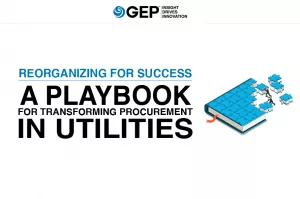Let’s face it: Procurement’s value to utilities is too often overlooked, with this critical function relegated to a supporting role — even though it’s essential to your organization’s success.
So, what’s holding procurement back? How can procurement take its rightful place and help transform utilities amid changing market dynamics, pricing pressure and an overreliance on legacy systems?
GEP’s new paper — Reorganizing for Success: A Playbook for Transforming Procurement in Utilities — tells you exactly how.
Our experts take you step by step through what you need to do to harness these three foundational components of every utility’s long-term success: people strategy, governance and technology innovation.
What’s Inside:
- Detailed ideas for attracting and retaining the best talent
- Concrete steps for boosting savings by eliminating governance gaps
- A road map for data-driven resilience
Utilities leaders need to read this important paper now to learn how to unleash procurement’s potential and make it an indispensable business partner.
EXECUTIVE SUMMARY
The utilities industry is facing unprecedented challenges because of changing regulatory requirements, increased price pressure, aging infrastructure, shifting market dynamics and technological innovation. Executives need to take action to transform procurement from a support function to a value-generating powerhouse. In this paper, GEP provides a detailed analysis of the structural and systemic failures of procurement and offers specific recommendations regarding: 1) Organizational Resources, 2) Technology, and 3) Governance. These three pillars create the foundation for transforming procurement into a best-in-class organization.
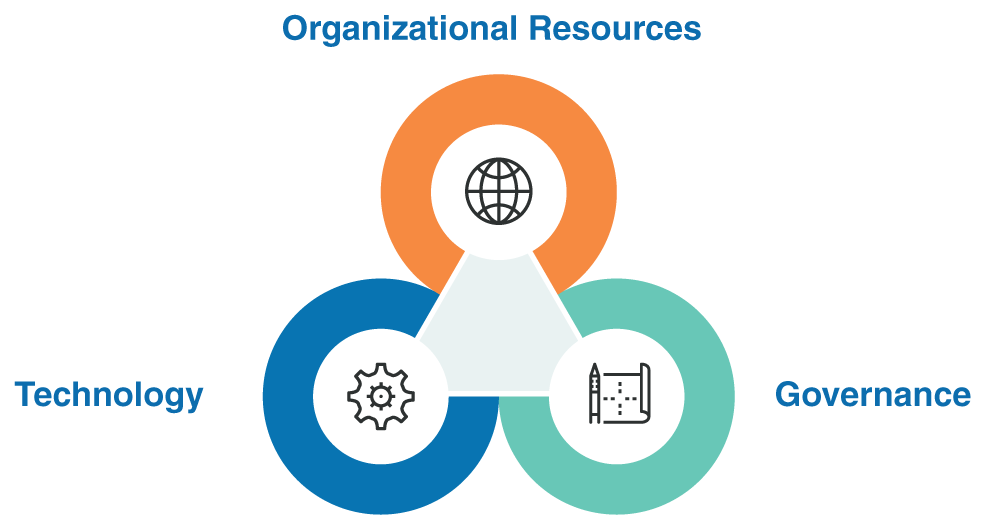
WHY THE UTILITIES INDUSTRY IS UNIQUE
Utilities in the United States are unlike any other industry in the world.
Over the past 200 years, utilities have evolved into regional monopolies regulated by a Public Utility Commission (PUC).1 Utilities are essentially run as a cost-plus model, and pass on costs to consumers, who rarely have an alternative. The larger the infrastructure built and invested, the larger the return. With greater economies of scale, utilities were able to vastly reduce the marginal cost to produce power.
Leading Fortune 500 corporations, on the other hand, cascade profit and loss goals top-down to drive accountability and financial performance. Management teams regularly review ways to increase revenue and decrease costs.
Not so for utilities.
Cost prudency is swept away from core values and placed with regulators. Stakeholders often struggle to understand the role of procurement and the value that it can provide. But it is beginning to change. Procurement can play a more meaningful, strategic role to help organizations achieve their short-term and long-term goals.
THE ROLE OF UTILITIES IS CHANGING, SO SHOULD PROCUREMENT
In 2020 and beyond, the utilities industry is changing fast and in several ways due to extreme environmental conditions,shifting consumer demand and efficiency-related innovations. Procurement and finance leaders who want to make an impact would be wise to pay attention to these trends and advocate for the strategic change that is needed to adapt.
WEATHER EVENTS ARE RAMPING UP REGULATORY PRESSURE
Severe and destructive weather events2 are increasing political pressure on utilities with more sophisticated policies and regulation. Electric system failures and pipeline explosions due to floods and wildfires are driving regulators to expand their role with increased scrutiny and greater accountability. Lawmakers and politicians are increasing the pressure to break up and restructure utilities. Many are advocating for policy changes to force utilities to become more cost-competitive by considering state- or federally run programs.
Procurement should: Develop a robust emergency response plan to prepare for major disruptions, including those caused by severe weather conditions, pandemics, and other force majeure events. In addition, utilities should invest in advanced technology and real-time weather monitoring systems. Advanced modeling of climate and storm data can be used to predict major disruptions.
DEMAND FOR RENEWABLES IS INCREASING
The world relies on multiple resources to generate electricity and is undergoing a rapid change. Renewables are the fastest growing segment and are expected to continue to grow steadily through 2050 because of declining capital costs, state and federal tax credits, Renewable Portfolio Standards (RPS), and other regulations and policies.3
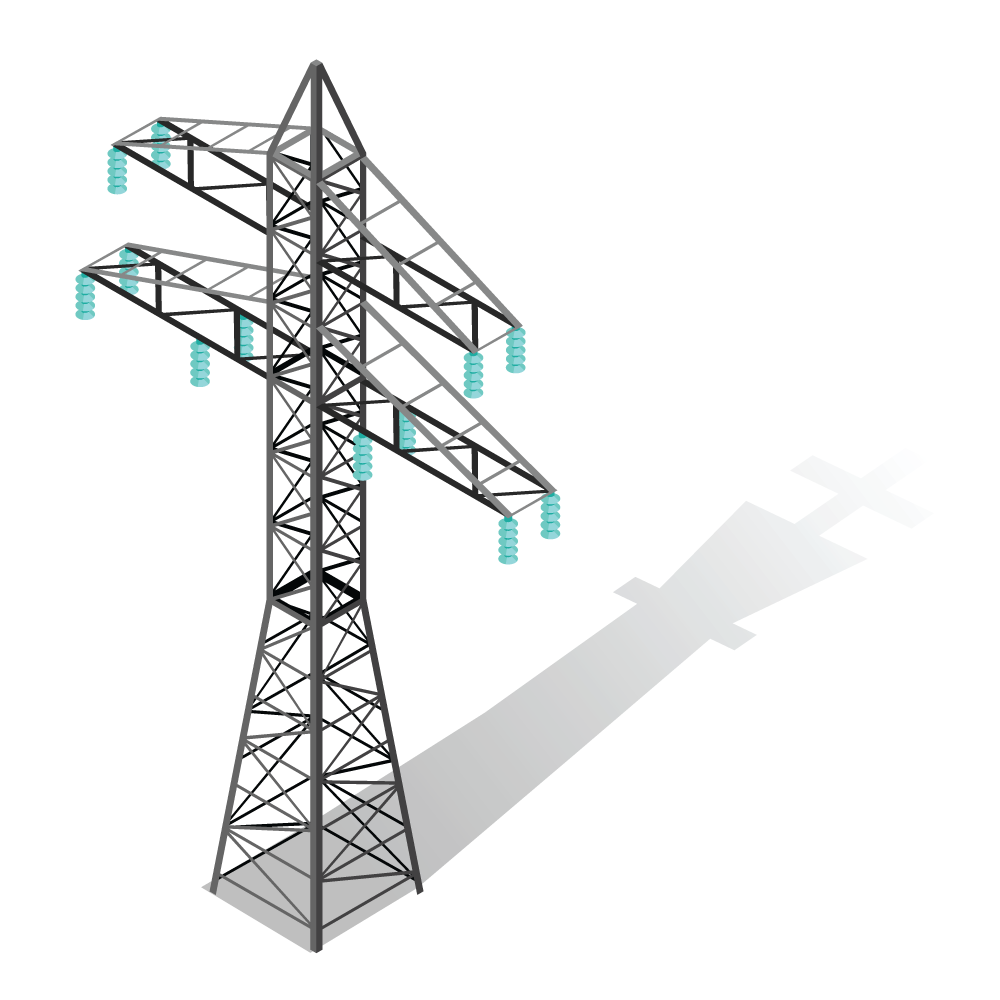
Procurement should: Update its strategic plan to account for changing legislation and macroeconomic changes. While most utilities have to comply with RPS, those leading the way are trying to exceed their goals by developing a holistic strategy and, at the same time, take advantage of decreasing costs of wind and solar. Many utilities are leveraging utilities-owned generation as well as long-term Power Purchase Agreements (PPAs). In doing so, supply chain needs to balance the benefits and risks associated with large capital investments and/or longterm contracts. Sourcing should take advantage of a competitive bid to achieve best-in-class pricing for renewables, which will reduce energy costs for their end consumers.
DEMAND IS DECLINING FOR TRADITIONAL POWER SOURCES
Coal-fired generation is declining because of climate change. In addition, nuclear facilities are being forced into retirement in the wake of the Fukushima Daiichi disaster, including the retirement of San Onofre and Diablo Canyon power plants in California.4
Procurement should: Plan for the retirement of aging assets and consider early retirements when O&M costs outpace fundamental economics. Procurement should work closely with its business partners to understand the remaining operating life of key assets; in many cases, procurement may need to engage engineering and technical experts to help develop a decommissioning plan and/or economic study. As these assets are sold or retired, utility leaders will need to have a comprehensive plan to transition the workload of those aging assets to renewables, PPAs, or other infrastructure.
TECHNOLOGY AND ENERGY EFFICIENCY ARE EVOLVING
Advancements in technology are substantially changing the utility ecosystem. Sophisticated control systems are improving safety and reliability. Advanced surveying and mapping technology are deployed to make more informed decisions. The digital workforce, predictive maintenance, battery storage, automated operations and processes, distributed generation, and many other innovations are taking root. Energy efficiency programs cause utilities to build less transmission infrastructure, but the demand for electric vehicle charging stations is surging.5
Procurement should: Be prepared for a changing technology ecosystem by studying the market and understanding how technological innovations are changing behavior. For example, as the demand for electric vehicles increases, additional infrastructure will need to be built to accommodate new charging stations. The location of these charging stations will change the demand on the grid, particularly around shopping malls and populated areas. In addition, the Internet of Things (IoT) will vastly change how a utility operates. Advanced smart meters and wireless devices will move beyond the meter, into people’s homes. IoT will enable energy to be optimized within a house or apartment, not just at the neighborhood level. With these advances in technology, supply chain professionals need to be prepared for changing contract requirements,such as additional cybersecurity requirements and changing consumer privacy laws.
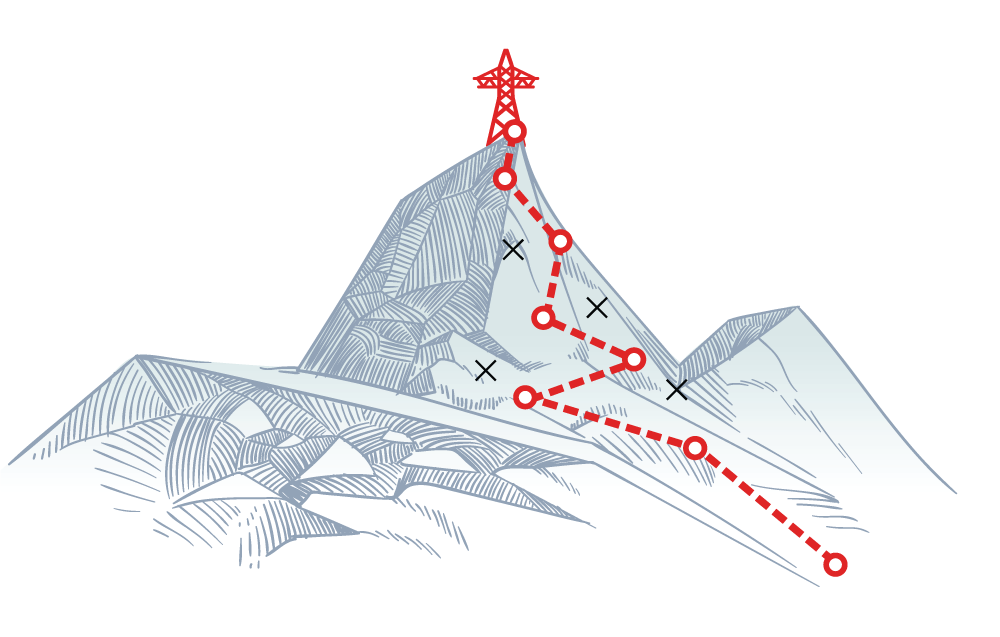
ORGANIZATION & RESOURCES
ORGANIZATIONAL FAILURES
A world-class procurement organization is held together by its people, structure, training, roles and responsibilities. Leaders in industries whose competitive advantage rests on low cost of purchase and delivery have developed sophisticated procurement functions that make day-to-day operations easier while simultaneously driving innovation. Yet, for many utilities, this is often a major source of failure.

Technical specifications, operations and maintenance schedules will differ, but vendor qualifications, supplier diversity, standardization, supplier relationship management, contracting, Key Performance Indicators/Service Level Agreements — and many other key areas of procurement — will not.
Procurement has been overlooked by utilities because they have been aligned with core business operations, such as power generation and transmission type, and have not been strategically designed to optimize value.
Breaking down these artificial walls will enable CFOs to reap hundreds of millions of dollars in savings that have never been captured. When looking across all industries for best-in-class market leaders, all forerunners have procurement at the helm.
It is time for utilities to make the same transition.
CONFLICTING ROLES & EXPECTATIONS: PROCUREMENT SEEN ONLY AS AN OBSTACLE
Procurement is often misunderstood. In some companies, it serves as a support organization. In other organizations, it directly oversees the work and plays a strict governance role. Sometimes, procurement and finance departments are so intertwined that they collectively function as a governance organization — where they approve budgets and contracts ensuring, that money is spent prudently and that contractors are treated fairly and equitably.
With such a wide range of roles and duties, project management and construction often do not see the value in a procurement organization. Most often, they do not understand why a given contract is not ready for them to use at will. It can be argued that those workers in the field should not have to deal with procurement-related supplier and contract issues at all. Often, the strategic value of procurement is in the work done to evaluate and mitigate risk exposure to the utility within a contract. Procurement might spend several weeks negotiating critical terms and conditions, such as in adding in a warranty clause. Most of the time, there is never an issue with the warranty, but in the event that a contractor fails to perform, the warranty clause can protect the utility against millions of dollars in liability. The worker in the field is often completely unaware that procurement has been negotiating these terms.
Most companies look to procurement teams for negotiating with suppliers to achieve cost savings; however, in practice, it is only a fraction of what a tyour organization into the future:ruly effective procurement organization should be doing. Many metrics that a mature procurement organization would use are not solely focused on hard dollar savings but on other service levels and metrics.
A REGULATED INDUSTRY WITH SILOS NEEDS TO EVOLVE & SEE PROCUREMENT STRATEGICALLY
The industry’s geographic and monopolistic nature enables utilities to fall into the trap of keeping business units disparate and isolated. Most utilities have siloed groups among fossil, renewables, nuclear, electric transmission, electric distribution, gas transmission, gas distribution, and corporate functions — while being held responsible to the constituents of a PUC. Historically, this made sense, as each business unit was strictly performing specific functions guided by engineering and operations.
Unfortunate events at sites such as Fukushima and larger trends in climate change have since decimated nuclear energy and coal production. They have forced utilities to add billion-dollar environmental systems for coal ash and nuclear waste or force power plants into retirement. Increasingly, retiring the fleet has been the answer.6
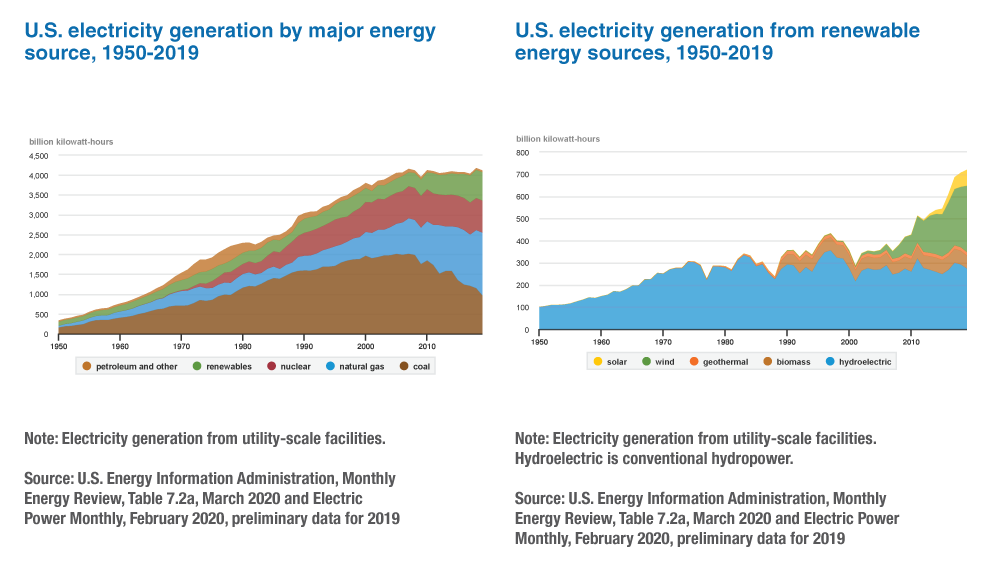
Natural events and technological advancement are proving that changes are afoot. Nuclear generation and coal are pushing steam through a turbine to generate electricity, for example, but this is where the similarities end in the eyes of today’s VPs and executives. The need for enterprisewide procurement capabilities is now self-evident.
TALENT ATTRACTION AND RETENTION
HIRING CHALLENGES
One of the major industry challenges is the lack of skilled workers and professional labor. Most companies compete headto-head for talent, but utilities control geographic regions. Often, this means that many utility workers spend their entire career working for one company7 and do not have the same pressure to compete or improve over time. With the exception of union hiring halls, there is no readily available pool of talented workers vying for the same job — at least, not at the same level as at Facebook or Google. Developing a hiring and retention strategy for skilled and professional labor is critical to the future of utilities.
A RETIRING WORKFORCE, A SKILLS GAP
With low turnover rates, a utility employee’s average age tends to be closer to retirement than in other industries.8 Unfortunately, newer generations of workers appear to have limited interest in working at utility companies.9, 10The typical employee at a utility has decades of knowledge that is highly specialized and critical to the core business operation. Yet, with an aging workforce, there is a considerable risk of losing institutional knowledge. While most utilities have a succession plan as part of their core business processes, most organizations do not have a strategy to transition knowledge from one person to the next.
LOSS OF INSTITUTIONAL KNOWLEDGE
It would be nearly impossible for a new employee to know why certain clauses or sections were included in a particular contract, specification, or scope of work.
Often, those decisions were made for a specific reason, but the rationale was not documented, so the knowledge disappears when the originator leaves. From a procurement perspective, it becomes increasingly difficult to develop new contracts because the specifications and scope of work are outdated. The skills to properly update this information are missing in the organization.
RESOLVING ORGANIZATIONAL ISSUES
DETERMINE THE RIGHT ORGANIZATIONAL STRUCTURE
- Tactics vs. strategy
- Negotiating vs. bidding
- Service levels vs. costs
- Process efficiency vs. risk
- Contract management vs. contract administration
Business leaders need to position their teams for success and think about how their group will interact with key stakeholders to be more successful.
FOCUS ON STRATEGIC VALUE AND LEVERAGE TECHNOLOGY FOR OPERATIONAL ISSUES
Most procurement professionals are focused on putting out daily fires. When arriving in the office, a half dozen issues will be on procurement’s desk. ABC Vendor did not receive payment. XYZ Vendor is not registered in the system. Fifteen POs have been blocked, and the list goes on. The business comes down hard on procurement to “fight these fires” so work can continue in the field to keep the grid live and customers happy. This forces procurement to be focused predominantly on transactional work rather than strategic efforts.
Segmenting your workforce into three distinct groups is the first step to correcting this challenge:
1. Strategic FTEs/SMEs
2. Tactical/Operational FTEs and
3. Digitally skilled FTEs
Each group has a different and clear role with associated tasks, yet notice how each overlaps, so communication between them is interlaced. This does not only enable change management and communication but provides each tier of employee visibility into what its co-worker is doing on a daily, weekly and monthly basis. Throughout an individual’s career, they have exposure to other roles in the procurement department, allowing employees to move among positions if they mature in their skill sets. It also provides a way to move skilled employees quickly and non-skilled FTEs to align procurement functions with business need. This also provides a path for millennial and newer generations of workers. Digital skill sets are hard to come by in the aging workforce of utilities. Here is how to set up the skills needed to propel your organization into the future:
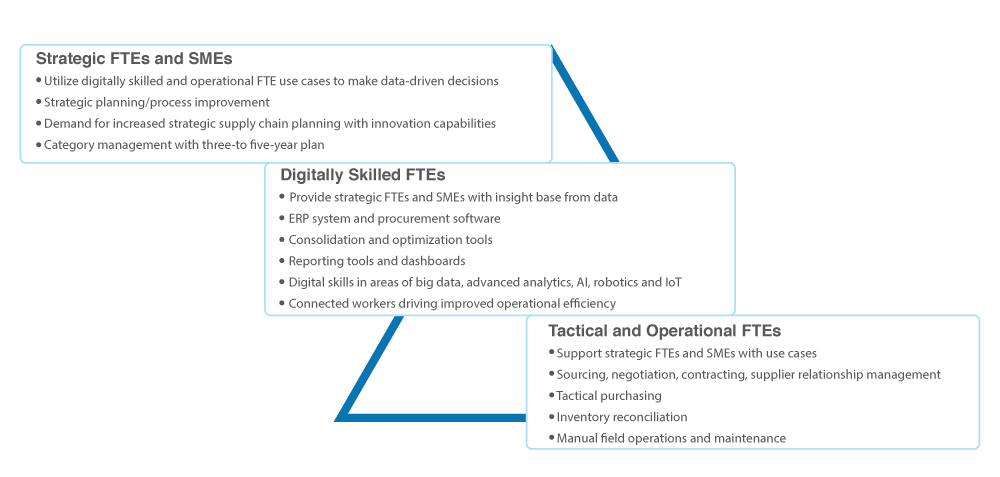
DELIVER MORE VALUE WITH FEWER RESOURCES
While the battle between silos continues, utilities have another option: Develop a cutting-edge operational model with procurement at the hub. Utilities have sophisticated supply chains designed by engineers and operations personnel. What is missing is procurement. Looking beyond two of the largest utility suppliers, such as Areva and Babcock & Wilcox’s engineering differences, synergies do exist across all generations and T&D. Procurement organizations should focus on optimizing and transforming the digital workforce to deliver more value with fewer FTEs.
- Lean Organizational Structure
- Create more customer value using fewer resources and optimal organizational structure
- Advanced Talent and Skills
- Add and upgrade digital skills of employees and union workforce
- Aligned Roles and Responsibilities
- Align the roles and responsibilities with supply chain vision, mission and objectives
- Cross-Functional Collaboration
- Increase cross-functional collaboration for improved visibility and decision-making across supply chain
- Flexible and Fluid Organization
- Incorporate speed and agility throughout the supply chain for faster speed to market
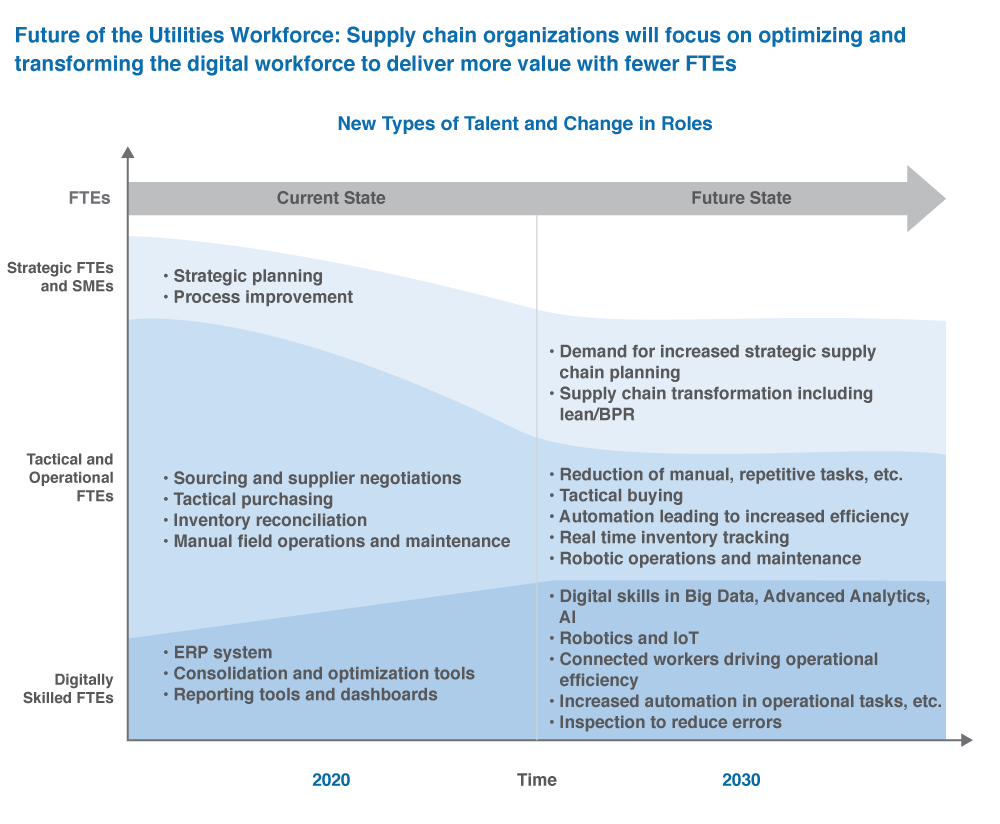
ESTABLISH EXPECTATIONS FOR ROLES & RESPONSIBLITIES
Procurement plays a critical role across the company. It is responsible for engaging the right stakeholders and making purchasing decisions. Yet, in most cases, the procurement team serves as an advisory role and should significantly influence critical business decisions. Many decisions can impact hundreds, if not thousands of people, which makes the process complex and often time consuming. For this reason, organizations must align their roles and responsibilities.

Individuals must understand who is responsible and accountable for their decisions and who should be informed or consulted before making those decisions. Some utilities go so far as to have service-level agreements with formal Responsible, Accountable, Consulted, Informed (RACI) matrices outlining what processes and findings they shall own. Developing the expectations for roles and responsibilities should be customized to each utility. Below are five models that can be deployed at your organization to keep your team optimized and agile:
1. Hierarchical Structure - Suitable for large workforce
- Grouping is done based on factors like function, category, geography, etc.
- Directs chain of command from the top of the organization to the bottom
- Allows few people to control all aspects of the organization which enables controlled orientation, but results in slow decision-making
2. Matrix Structure - Suitable for large and complex projects
- People with similar skills are pooled together for work assignments,resulting in dual-reporting relationships
- Allows sharing of highly skilled resources between functional units and projects, but can also create confusion when employees have two managers
3. Horizontal/Flat Structure - Suitable for small companies and early-stage startups
- Levels of middle management are eliminated
- Decision-making occurs at staff level
- Enables quick decision-making but also creates power struggle
4. Network Structure - Suitable for organizations with large suppliers and service providers
- Relies on open communication and reliable partners, both internal and external
- Less hierarchical, more decentralized and flexible than other structures
- Using it is sometimes a disadvantage because of its complexity
5. Divisional Structure - Suitable for large utilities with multiple product lines
- Each division contains the resources needed to support the business unit and geography
- Independent operational flow, i.e., the failure of one division doesn’t threaten existence of others, but it can create operational inefficiencies due to the separation of specialized functions
DELIVER MORE IMPACTFUL TRAINING
Developing a robust training program for your organization is challenging but necessary. A one-size-fits-all approach to training is often ineffective.11 Developing strong procurement skills with an understanding of operations is critical, and so is aligning these resources to optimize the impact on the organizational model. The procurement team should be agile, flexible and able to adapt to ever-changing business requirements.
In practice, though, you’ll find a mix of strengths and weaknesses in any organization. Employees may be skilled at negotiations, analytics, commutations, writing contracts, or strategic thinking. Having all of these skills together is the objective. It is common for leadership to be unaware of skill gaps within their organization. Often, creating a training program becomes more of a compliance exercise than developing a focused effort around skill deficiencies.
Most procurement organizations have developed their own customized processes and policies and do not train their employees, except on the job. Basic questions such as, “When should I consult with legal?” can cause major disruptions in the end-to-end procurement process and threaten project timelines when policies are not clearly defined.
The long-term impact of operating as a siloed organization creates several side effects that go unrecognized by most executives because they are unable to see the forest for the trees. Designing a strategic organizational model is as essential as having clearly defined roles and responsibilities.
Building these new skills internally can take years. Many leading utilities and savvy executives typically rely on a third party to roll this plan out in one to three years instead of five to seven years when done internally.

STRATEGIES FOR ATTRACTING AND RETAINING TALENT
Reviewing employee performance management criteria and understanding motivation strategy are the cornerstones of retaining and attracting top talent. Procurement leaders tend to lack the career path and training needed to develop a highly efficient team. It’s key to partner with Human Resources to develop a robust employee performance management program and develop a career path for each role. Motivate and create incentives your employees with compensation, training curricula and a sustainable development plan. The illustration below shows how intertwined employee retention and attraction is:
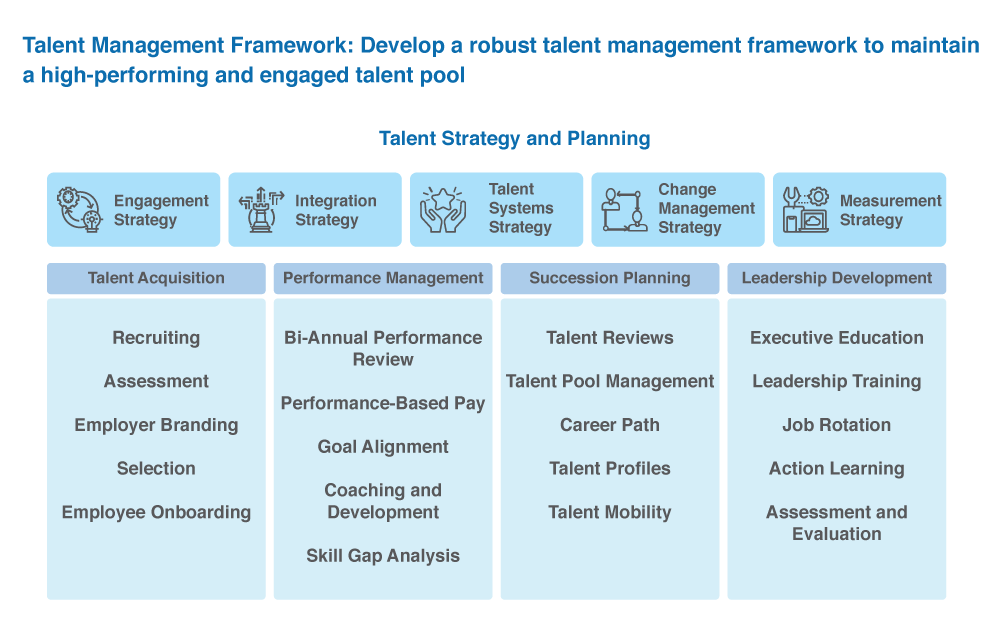
TECHNOLOGY
Technology cripples most utilities, which seems like a paradox. After all, utilities are the definition of “big data” with asset information, geolocations, material codes, customer data, specifications, contracts and change orders, invoices, and payments. Yet, most utilities struggle with extracting basic data in a simple and meaningful way. Today’s advancements in artificial intelligence and machine learning can allow organizations to better use employees and help procurement achieve that higher level of strategic value.
TECHNOLOGY IMPLEMENTED OUT OF NECESSITY
Many utilities have retroactively implemented ERP systems out of necessity, rather than thoughtfully and strategically. Technology implementations always take longer and are more complex than most people realize. Lack of resources and skills can be detrimental to technology implementation. Often, technology is implemented based on a current state, with aspirations to a future state, but there is usually not a cohesive plan to get from point A to point B.
MANUAL PROCESSES
Many utilities have processes that have been in place for decades. Many of these processes are labor intensive and were designed prior to modern computer architecture. Over the last five years, there have been enormous automation advancements that have vastly improved the end-to-end process12 and substantially reduced administrative costs.13 It would not be uncommon for some utilities to have an archive of paper contracts filed away, while other utilities might have a combination of paper and electronic archives; few utilities have a complete digital solution.
INCONSISTENT SPECIFICATIONS, SCOPE OF WORK, AND REQUISITIONS
Many utilities rely on the same engineering designs and specifications for decades. Yet, at the same time, engineering and design software has never been more advanced or powerful. Updating records is often time consuming and expensive. Manual processes and antiquated technology get in the way of improving operations, reliability and safety. Technology advancements, improved software, advanced mapping techniques, cloud architecture, and mobile deployment for field operations redefine how specifications and scope of work are created and managed. Many utilities are not positioned to take advantage of these changes. Data is becoming richer, with 3D scans and models, yet, only a handful of utilities have successfully implemented programs to modernize their designs.14
PROCESSING CONTRACTS & CHANGE ORDERS
Pulling contracts to review change orders can be an administrative nightmare. Even utilities transitioning from paper contracts to digital contracts still rely on PDFs that have been scanned and contain no metadata. Technologies like Optical Character Recognition (OCR), Robotic Process Automation (RPA), and Machine Learning (ML) allow corporations to unlock their data potential. The data can be mined to answer tactical and strategic questions and can help monitor risk and compliance. For example, developing a standard clause library to reduce the number of terms and conditions can improve cycle time, reduce costs, drive standardization, and lower risk.
PROCESSING INVOICES & PAYMENTS
Posting receipts for goods, reviewing invoices and issuing payments — while ensuring proper oversight and compliance — are administratively burdensome. Utilities often have teams of people administering contracts, but usually a large portion has minimal supervision. Adding more people to review each invoice exponentially increases the complexity and drastically increases the cost. Advances in Accounts Payable (AP) automation can vastly decrease the costs and can scale across global organizations. Most AP automation solutions benefit from artificial intelligence and machine learning algorithms that can help manage rote AP processes more effectively than any human team.
ANTIQUATED SYSTEMS
Why don’t utilities leverage newer technologies? Part of the answer has to do with antiquated systems. Most utilities have disparate systems and processes implemented for a single purpose (e.g., issuing a single ticket to dispatch a job at a specific location). Those systems have been modified over time and have no standard application programming interface, so importing and exporting data is a manual effort. In many instances, those systems have become core applications and migrating away from them becomes increasingly difficult over time.
LACK OF DATA VISIBILITY
Data visibility across the enterprise is often a challenge. With siloed organizations and disparate systems, each business unit operates independently. Some business units might be diligent about planning their work and bidding every single project. Other business units might assign work based on geography or regions. Some business units might require detailed invoices and documentation, while others might only require the foreman’s signoff. Without a unifying technology and process, these factors compound each other and make collecting data difficult.
One of the common ways to measure a utility’s maturity is by measuring the amount of spend under management. However, “under management” often has a loose definition. Does it mean that every dollar is a bid? Does it mean that every dollar is issued against a purchase order? Does it mean that every invoice has been reviewed? How much is on a P-card? How much is processed without a contract in place?
POOR DATA INTEGRATION AND MANUAL PROCESSES
A great deal of effort goes into developing a rate case and pulling data. Arguably, a utility’s rate case is the single most important factor for revenue generation. Utilities dedicate an enormous amount of money for consultants and specialists during the rate case process but often neglect the data. A single data request for a rate case might pass through a dozen different hands before making it to a regulator. With foundational technology and a unified system, data requests for rate cases would likely be 30% to 50% more efficient and/or less costly.

TECHNOLOGY RECOMMENDATIONS
DEVELOP A TECHNOLOGY ROADMAP
Utilities need to create a unified technology roadmap that plans for complete integration of all systems, including disaster recovery, cybersecurity controls, and serving as a single source of truth for the company. Having a comprehensive view of and access to clean data are paramount for making decisions. Clean and reproducible reports enable everyone, from field employees to executive leadership, to make more informed decisions.
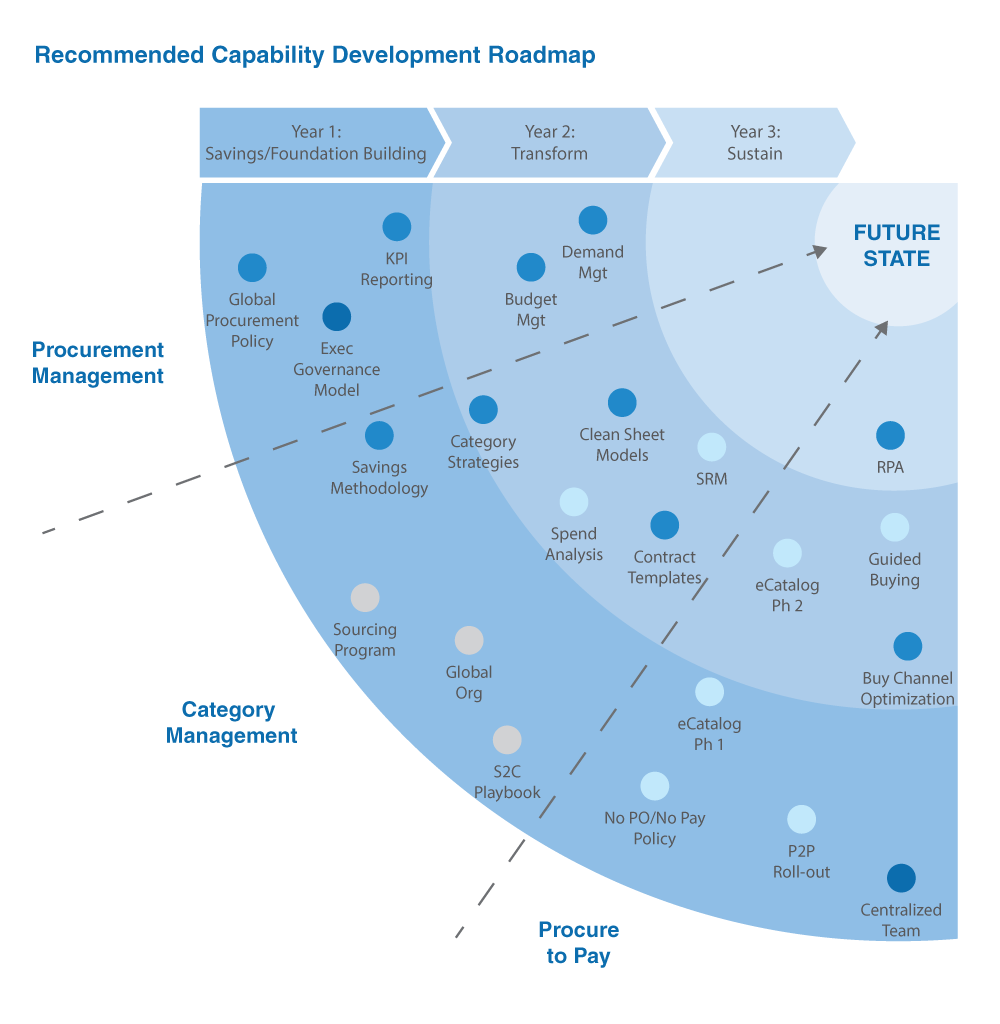
UNDERSTAND YOUR REPORTING NEEDS
It is critical to think about your reporting needs:
- What questions do you want to answer with the data?
- Who will be accessing the data?
- How frequently will the data be updated?
- How will users interact with the reports?
- Where will the underlying information be coming from?
- Who will manage the system and correct data gaps?
Almost everyone would agree on the need for a “spend report,” but the spend report might be different for a category lead, executive, or finance or engineering employee. Each user may need to apply different filters to create an appropriate report. Most modern technology solutions can create views for specific users and can be automatically pushed via email to provide timely updates on a routine basis. Best-in-class reporting tools can parse millions of transactional data lines and provide cleansed reports in less than two weeks. Implement a procurement system that can adapt to your business needs.
Not all ERP systems are the same. Some excel at material management or logistics. Some allow punchout catalogs. Some are geared toward bidding and running RFPs. It is important to select an ERP system that can scale with your business needs. Leading procurement systems can drive significant savings by streamlining your operations. Often these systems have substantial competitive advantages that:
- Provide guided buying to help simplify the purchasing process
- Standardize terms and conditions with a standard clause library
- Easily flip quotes to requisitions and purchase orders
- Automate invoice review with artificial intelligence to secure early payment discounts
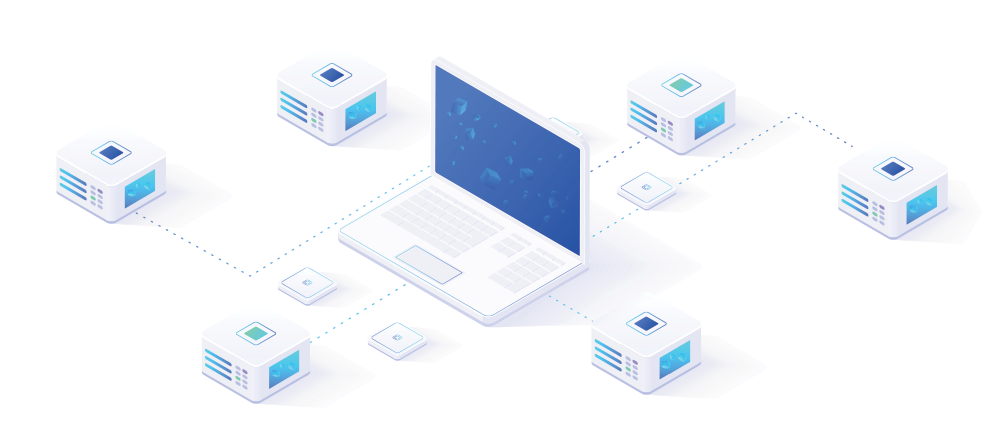
UNDERSTAND YOUR DATA ECOSYSTEM
Even with a single procurement system, critical data often reside in different tables. Merging structured data tables or cleansing unstructured data can yield very different results and is highly dependent on the user’s understanding of the data ecosystem. Advanced systems can help automate this process to deliver more accurate and consistent results.
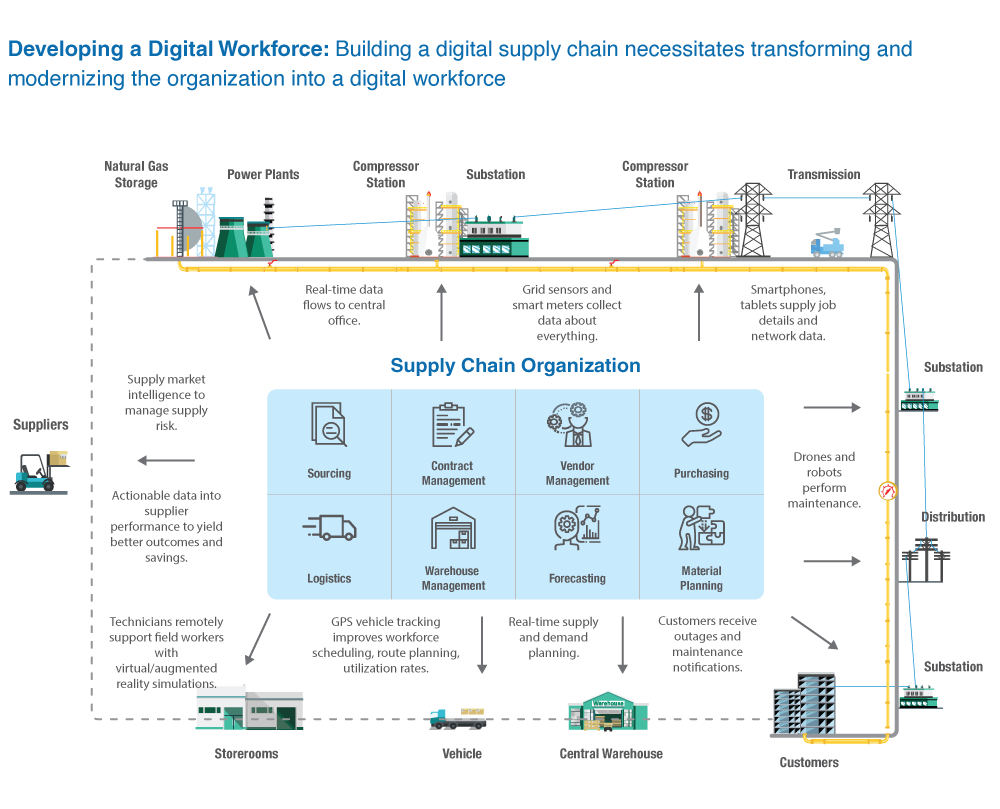
GOVERNANCE
LACK OF GOVERNANCE DIMINISHES SAVINGS
As it’s such a highly regulated industry, the lack of governance in a utility often takes outsiders by surprise.15 The work is complex, specialized and involves dozens of different disciplines. Stakeholders are responsible for their respective parts, but when goals span multiple stakeholders and participants, it becomes increasingly difficult for an individual to control the outcome. Ultimately, finance might be accountable for meeting the company’s financial goals, but the majority of the spend is overseen by project management and construction. This makes it difficult for finance to come in under budget when it is so far removed from the operational decisions. Yet, regulators continually review rate cases and ask for proof that funds were spent prudently. Proper governance can drive savings and empower individuals to make the right decisions.
GETTING A SEAT AT THE TABLE
Strong governance starts with people. The right people with the right skills need to be involved. Normally, this begins at the top of the organization. Directors and VPs typically have greater influence on the decision-making process. However, most CFOs cannot tell you whether you should build a pipeline using a horizontal direction drill or an open trench. There is an element of experience and expertise level required to pull the right stakeholders together to make the right decisions for the company. Developing that knowledge is difficult and often comes with time. But finding that experience in procurement is often viewed as an impossible task.
In order for procurement to have a seat at the table, it needs to demonstrate its knowledge and speak credibly to the business unit. More importantly, procurement leaders need to be able to understand the work if they are going to have any hope of acting as advisors.
RECOMMENDATIONS FOR IMPROVING GOVERNANCE
IMPLEMENT A CROSS-FUNCTIONAL GOVERNANCE COMMITTEE
Implementing a cross-functional governance committee to review programmatic goals and objectives can streamline decisions and drive savings. A robust framework can provide visibility and control, and it can ensure success. Some utilities have created a two-tiered, collaborative governance structure to:
- Achieve program objectives
- Align program and business strategies
- Manage communication effectively
The top-tier program committee typically involves executive leadership to discuss major issues and pain points. They are the ultimate decision-makers and are responsible for resolving problems and/or escalations.
The bottom-tier operational committee typically involves a dedicated working team that understands the day-to-day project requirements. They manage daily operations and resolve daily operational issues, while providing guidance and oversight.
IMPLEMENT A SPEND CONTROL TOWER
One of the strategies that sourcing organizations can implement to help bridge the gap between their business stakeholders is to create a spend control tower. A properly deployed spend control tower can help improve governance and reduce procurement cycle times, all while opening communication lines to key individuals. With the right process and rigor, organizations can engage the right people to ask more meaningful questions:
- Is the right contractor assigned to this project?
- What percent of the budget will be eaten away by issuing this contract?
- What steps have we taken to ensure that the project will be completed safely and on schedule?
CONCLUSION
The unprecedented challenges in the utilities industry are complex and filled with nuances that can take a lifetime to understand and master. Rather than sitting idle and waiting for external forces to create change, utility leaders need to take a proactive approach and learn to adapt. The right people, processes, and technologies can transform a company destined for failure and set a course for long-term success. This journey will be difficult but achievable. Procurement will play a critical role in helping to achieve the company’s goals and serving as a communications conduit across the organization by developing key partnerships with teams and departments — including new suppliers, contractors, and third-party providers. Over time, more and more will be asked of procurement as the organization establishes itself as a valued partner at the table that can influence, advise, and guide the company on the path to success.
AUTHORS

Jason Allukian
Director, Consulting
Jason is responsible for managing large-scale strategic sourcing and supply chain projects in the energy and utility sectors at GEP. His areas of expertise include supply chain transformation, procurement, operations and maintenance strategy, negotiations, category management and supplier management. Prior to GEP, he has worked with a consulting firm, leading client-facing teams to develop and execute sourcing strategies of over $15 billion for Fortune 500 energy companies
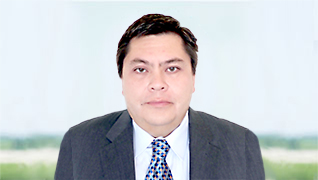
Micah Sze
Director, Utilities
Micah has over 15 years of experience in the energy and utility industry. He is an expert in strategic sourcing, category management, negotiations, SRM, data analysis and visualization.
He has helped establish a strategic alliance to replace and repair thousands of miles of gas transmission pipelines and handled procurement activities for electric transmission and distribution across North America.
1 Richard D. Pomp, “A Brief History of the Electric Utility Industry (2000),” SSRN, 17 July 2017. Retrieved 20 October 2020 from https://ssrn.com/abstract=2999134 Organizational Resources Technology Governance
2 A.T.D. Perera, Vahid M. Nik, Deliang Chen, Jean-Louis Scartezzini & Tianzhen Hong, “Quantifying the Impacts of Climate Change and Extreme Climate Events on Energy Systems,” Nature Research, 17 February 2020. Retrieved 20 October 2020 from https://www.nature.com/articles/s41560-020-0558-0
3 “Annual Energy Outlook 2020 With Projections to 2050,” The U.S. Energy Information Administration (EIA), 29 January 2020. Retrieved 20 October 2020 from https://www.eia.gov/outlooks/aeo/
4 Kelly Andrejasich and Anna Duquiatan, “7 Gw of Us Nuclear Capacity Could Close in Next 5 Years,” S&P Global Market Intelligence, 26 May 2020. Retrieved 20 October 2020 from https://www.spglobal.com/marketintelligence/en/news-insights/latest-news...
5 “The Future of Electricity: New Technologies Transforming the Grid Edge,” World Economic Forum, 10 March 2017. Retrieved 21 October 2020 from https://www.weforum.org/reports/the-future-of-electricity-new-technologi...
6 “More U.S. Coal-Fired Power Plants Are Decommissioning As Retirements Continue,” The U.S. Energy Information Administration (EIA), 26 July 2019. Retrieved 21 October 2020 from https://www.eia.gov/todayinenergy/detail.php?id=40212
7 “Employee Tenure In 2020,” U.S. Bureau of Labor Statistics, 22 September 2020. Retrieved 21 October 2020 from https://www.bls.gov/news.release/pdf/tenure.pdf
8 Jon O’Connell, “Third of Utility Workforce Reaching Retirement Age Soon,” Energy Central Power Industry Network, 29 Jan 2017. Retrieved 21 October 2020 from https://energycentral.com/news/third-utility-workforce-reaching-retireme...
9 “Building an Energy Workforce for the 21st Century,” U.S. Senate Committee on Energy & Natural Resources, August 2016. Retrieved 21 October 2020 from https://www.energy.senate.gov/services/files/4269D9FB-3713-4371-AD66-CE9...
10 John D. McDonald, “Meeting the Utility Workforce Challenge,” T&D World, 10 September 2019. Retrieved 21 October 2020 from https://www.tdworld.com/safety-and-training/article/20973078/meeting-the...
11 Rachel Collier, “Redefining the Framework: Utility Training Benchmark Findings,” Western Energy Institute, 2 August 2018. Retrieved 21 October 2020 from https://www.westernenergy.org/news-resources/redefining-the-framework-ut...
12 Raymond Perrault, Yoav Shoham, Erik Brynjolfsson, Jack Clark, John Etchemendy, Barbara Grosz, Terah Lyons, James Manyika, Saurabh Mishra, and Juan Carlos Niebles, “The AI Index 2019 Annual Report,” Stanford University, December 2019. Retrieved 21 October 2020 from https://hai.stanford.edu/sites/default/files/ai_index_2019_report.pdf
13 “Trends in Procurement Technology: Missing Piece in End-to-End Procurement,” GEP, 18 March 2016. Retrieved 21 October 2020 from https://www.gep.com/white-papers/trends-procurement-technology-missing-p...
14 Shakil Ahmed, “Barriers to Implementation of Building Information Modeling (BIM) to the Construction Industry: A Review,” Journal of Civil Engineering and Construction, 19 May 2018. Retrieved 21 October 2020 from https://www.researchgate.net/publication/325253434_Barriers_to_Implement...
15 Timothy Irwin and Chiaki Yamamoto, “Some Options for Improving the Governance of State-Owned Electricity Utilities,” The World Bank, February 2004. Retrieved 21 October 2020 from https://openknowledge.worldbank.org/handle/10986/21603
Theme: Procurement

